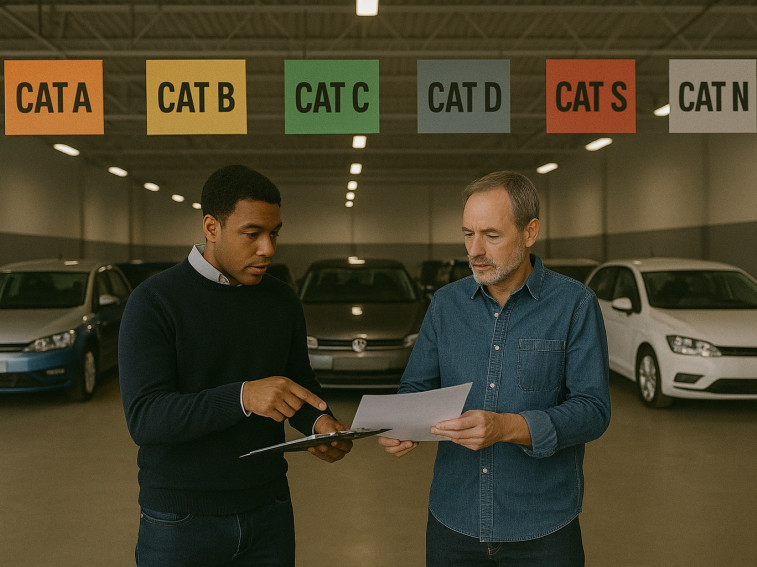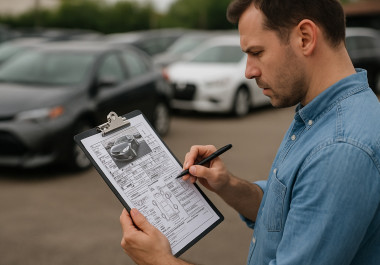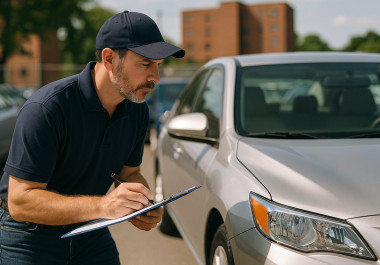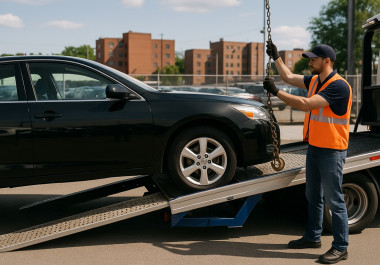When navigating online vehicle auctions, prospective buyers frequently encounter specific codes in the listings, such as CAT A, CAT B, CAT S, and CAT N. These are not arbitrary administrative notes; they are crucial car auction categories that provide a detailed history of a vehicle's condition and its potential for future use. For any potential bidder, these labels are a primary source of information regarding value, safety, and legality. A thorough interpretation of these codes is the key to differentiating a genuine opportunity from a significant financial risk.
This guide provides a detailed explanation of this classification system, moving beyond simple definitions to explore the practical implications for all types of buyers. A clear grasp of these categories empowers you to make informed decisions, accurately assess potential risks, and ultimately bid with confidence. At RAW2k, you will find a wide spectrum of vehicles, including those with salvage categories. Should you have questions about our auction platform, our team is always available to assist via the RAW2k contact page.
Defining the Core Meaning of Salvage Categories
Before a vehicle is assigned a category, it has been declared an "insurance write-off." This event occurs when an insurer, after assessing the damage from an incident like an accident or flood, determines that the vehicle is uneconomical to repair. At this point, the insurer typically settles the claim with the policyholder and takes ownership of the vehicle. The car is then given a category that serves as an official verdict on its condition and future. This system creates a clear and transparent framework for the vehicle's subsequent sale, often through auctions.
The Unrepairable Verdict: CAT A & CAT B
These two initial categories are reserved for vehicles that must never legally return to the road, representing the complete end of their lifecycle as functional transport.
-
Category A (Scrap Only): This is the most severe classification. A vehicle designated as CAT A has sustained catastrophic damage, making it entirely unsafe and beyond any form of repair. The damage could originate from a severe structural impact, a vehicle fire, or significant water contamination. Under UK regulations, a CAT A vehicle must be completely destroyed, including all of its parts. It is sold only to be depolluted and crushed.
-
Category B (Break for Parts): A CAT B vehicle is also deemed non-repairable, with its structural body shell or chassis being so compromised that it must be crushed. However, unlike CAT A, this category allows for the legal reclamation of serviceable parts. A licensed vehicle dismantler can carefully remove and sell undamaged components and safe for reuse, such as the engine, gearbox, interior elements, or infotainment systems. The remaining bodyshell is then destroyed.
The Repairable Verdict: CAT S & CAT N
These categories signify that while the vehicle has been written off, it is considered suitable for repair and can legally be returned to the road, provided specific standards are met.
-
Category S (Structural Damage): The 'S' explicitly stands for Structural. A CAT S vehicle has sustained damage to its core structural frame or chassis. This could be a bent chassis leg from an impact, a compromised A-pillar from a rollover, or damage to the suspension mounting points. The repairs required are substantial and demand a high level of technical expertise to ensure the vehicle's foundational integrity is safely and correctly restored. Its history is permanently recorded as having had structural damage.
-
Category N (Non-Structural Damage): The 'N' signifies Non-Structural damage. This means the vehicle's primary structure, or "skeleton," is intact and has not been compromised. The damage that led to the write-off is related to other areas. This could include cosmetic issues like damaged bumpers, doors, and wings; problems with complex electrical systems like the ECU or wiring looms; or significant interior damage from water ingress. While the repairs can still be extensive and costly, they do not involve correcting the core chassis.
A note on former categories: In October 2017, the CAT S classification replaced the older CAT C, and CAT N replaced CAT D. The new system focuses more on the type of damage rather than solely the cost of repair, providing greater clarity.
Analysing the Financial Implications: Bargain Versus Burden
The main appeal of a salvage vehicle is its price, but this is only the beginning of the financial story. A careful analysis of all potential costs is essential to determine if an apparent bargain will not become a financial burden.
The Upfront Advantage
The most evident benefit is the significantly lower purchase price. A vehicle classified as CAT S or CAT N will be available for a fraction of the cost of an equivalent model with a clean history. This initial discount is the primary incentive for buyers, offering a pathway to owning a higher-specification, newer, or more desirable model for a reduced initial outlay. This potential for value is a major driver of the salvage auction market.
The Hidden and Ongoing Costs
The attractive purchase price can be deceptive if the full spectrum of associated costs is not considered. A true calculation of the vehicle's total expense must include:
-
Comprehensive Repair Expenses: This is the largest variable. It includes not just the cost of replacement parts (which can be OEM, aftermarket, or second-hand) but also the cost of professional labour. CAT S repairs often require specialist equipment, such as chassis alignment jigs, which carry high labour rates.
-
Elevated Insurance Premiums: Insurers view repaired salvage vehicles as a higher risk. Consequently, annual premiums are often substantially higher than for a standard vehicle. Some insurers may refuse to offer comprehensive cover, limiting you to third-party policies. It is essential to research specialist insurers.
-
Permanent Lower Resale Value: The salvage category marker is a permanent part of the vehicle's official history. Even if repaired to a standard indistinguishable from the original, its history will always result in a significantly lower market value compared to a non-salvage equivalent. This depreciation is a long-term financial factor.
The Path to Roadworthiness: Legal and Practical Steps
Purchasing a repairable salvage vehicle initiates a process. Returning it to legal road use involves meeting specific requirements that differ significantly between the two repairable categories.
The CAT N Journey
A CAT N vehicle, having no recorded structural damage, does not require a specific inspection by authorities to be re-registered after its repairs are complete. However, the owner has a legal responsibility to ensure the vehicle is repaired to a safe and roadworthy standard. If the vehicle is over three years old, it will still need to pass a standard MOT test before it can be taxed and driven legally.
The CAT S Journey
The process for a CAT S vehicle is far more stringent. Due to the structural nature of the damage, repairs must be completed to a professional and verifiable standard. After this work is finished, the vehicle must undergo and pass a thorough MOT test. The Driver and Vehicle Licensing Agency (DVLA) will not issue a new V5C logbook for the vehicle without this official confirmation that its core structure is safe for road use.
The Final Step for Both: DVLA and Insurance
Once repaired and appropriately tested, an application must be made to the DVLA for a new V5C logbook. This document will be issued with a note on it, clearly stating that the vehicle has been previously salvaged. This ensures transparency for any future owner. Securing insurance is the final critical step before the vehicle can be taxed and legally driven. To participate in auctions on our platform, you will first need to complete the registration process.
Matching the Buyer to the Category: Assessing Suitability
Salvage vehicles are not suitable for every buyer. The ideal owner profile varies significantly depending on the category of damage and the resources available to them.
-
The Ideal CAT B Buyer: This is almost exclusively a professional and licensed vehicle dismantler or a mechanic building a specific project car. Their goal is to acquire a donor vehicle for its engine, transmission, or other major components, not to repair the CAT B car itself.
-
The Ideal CAT S Buyer: This role is best suited for an experienced professional in a body shop or a structural repair specialist. They must possess the correct specialist equipment and a deep technical understanding of how to safely and accurately repair a vehicle's chassis.
-
The Ideal CAT N Buyer: The potential market for CAT N vehicles is broader. It includes skilled home mechanics, professional car traders, and budget-conscious buyers who can accurately assess non-structural damage and are confident in managing or performing the necessary repairs. Success in acquiring a salvage vehicle safely at auction in this category often hinges on accurate damage assessment.
-
The Simpler Alternative: For the majority of buyers who want a vehicle without the inherent risks and complexities of salvage repair, exploring the wide range of standard used cars is the most secure option. The regular vehicle auctions on RAW2k feature thousands of non-categorised vehicles, from everyday cars to commercial vans in our van auctions, offering a much more straightforward path to ownership.
A Pre-Bid Safety Checklist for Buyer Protection
Before committing to a salvage vehicle, a disciplined and methodical approach is essential. Using a clear checklist is a key part of how to buy a salvage vehicle safely at auction and can help protect your potential investment.
-
Check 1: Read the Report: Meticulously examine every detail of the auction listing and all accompanying photographs. Understand the reported damage as thoroughly as possible, noting any areas that are not clearly visible.
-
Check 2: Verify the History: Always perform a full vehicle history check from a reputable provider. This will independently verify the salvage category and alert you to other critical information, such as whether the vehicle is recorded as stolen or has outstanding finance. This check is fundamental to buying a salvage vehicle safely at auction.
-
Check 3: Quote the Repair: Obtain realistic and detailed cost estimates for both parts and labour from reputable repairers before you place a bid. This should be treated as a core part of your budget calculation.
-
Check 4: Clear the Insurance: Contact insurance companies that specialise in salvage vehicles in advance. Confirm they will insure the specific category of vehicle and get quotes to understand the likely annual cost.
Conclusion
A thorough understanding of car auction categories is an indispensable tool for anyone considering a purchase from an auction, especially if it involves a salvage title. While CAT S and CAT N vehicles can offer the opportunity for substantial initial savings, they are accompanied by inherent risks and responsibilities regarding repairs, roadworthiness, and insurance. By diligently researching a vehicle's history, accurately estimating all potential costs, and fully understanding the implications of its salvage category, you can make a well-informed decision and potentially secure excellent value.
Begin your search today by browsing the diverse listings in RAW2k’s vehicle auctions, where you can find a vast selection of both salvage and standard used cars to suit all needs and skill levels.




